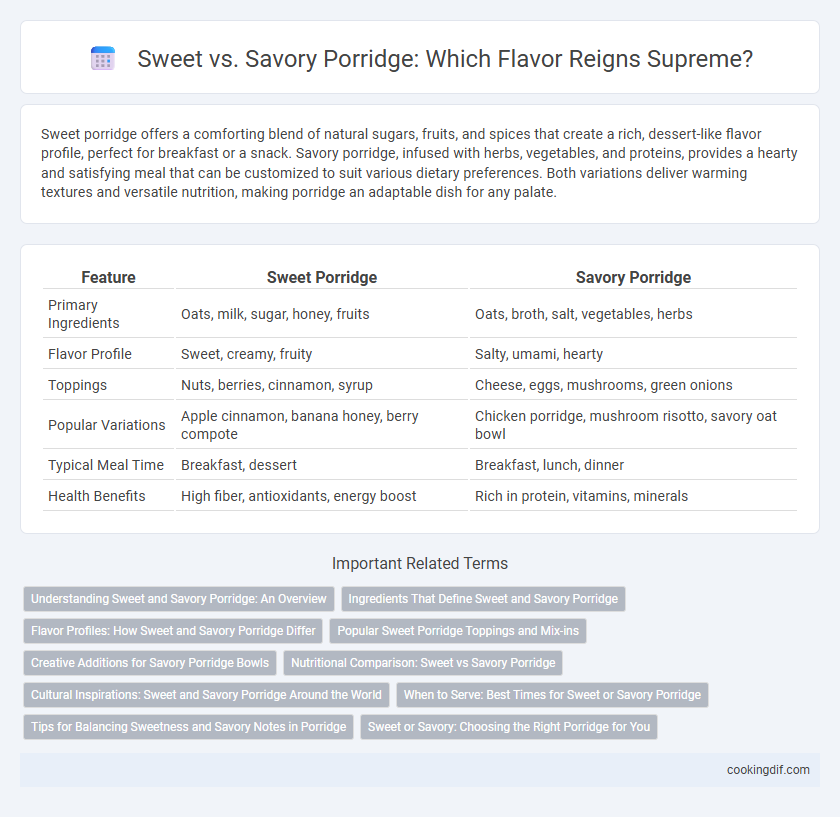Sweet porridge offers a comforting blend of natural sugars, fruits, and spices that create a rich, dessert-like flavor profile, perfect for breakfast or a snack. Savory porridge, infused with herbs, vegetables, and proteins, provides a hearty and satisfying meal that can be customized to suit various dietary preferences. Both variations deliver warming textures and versatile nutrition, making porridge an adaptable dish for any palate.
Table of Comparison
| Feature | Sweet Porridge | Savory Porridge |
|---|---|---|
| Primary Ingredients | Oats, milk, sugar, honey, fruits | Oats, broth, salt, vegetables, herbs |
| Flavor Profile | Sweet, creamy, fruity | Salty, umami, hearty |
| Toppings | Nuts, berries, cinnamon, syrup | Cheese, eggs, mushrooms, green onions |
| Popular Variations | Apple cinnamon, banana honey, berry compote | Chicken porridge, mushroom risotto, savory oat bowl |
| Typical Meal Time | Breakfast, dessert | Breakfast, lunch, dinner |
| Health Benefits | High fiber, antioxidants, energy boost | Rich in protein, vitamins, minerals |
Understanding Sweet and Savory Porridge: An Overview
Sweet porridge typically features ingredients like honey, fruits, nuts, and spices such as cinnamon to create a rich, flavorful breakfast option, while savory porridge incorporates vegetables, herbs, cheese, or meats for a hearty, nourishing meal. The base grain, often oats, rice, or millet, remains consistent, but the choice of toppings and mix-ins defines the distinct sweet or savory profile. Understanding these variations allows for versatile porridge recipes that cater to different dietary preferences and meal occasions.
Ingredients That Define Sweet and Savory Porridge
Sweet porridge typically includes ingredients like brown sugar, honey, fresh or dried fruits, cinnamon, and vanilla, which create a rich, aromatic flavor profile. Savory porridge often features vegetables, herbs such as chives or thyme, cheese, and proteins like eggs or bacon to deliver a hearty, umami taste. The choice of toppings and seasonings fundamentally distinguishes sweet porridge's creamy sweetness from the robust, spiced depth of savory varieties.
Flavor Profiles: How Sweet and Savory Porridge Differ
Sweet porridge features natural or added sugars, fruits, cinnamon, and vanilla, creating a warm, comforting flavor profile with a hint of sweetness and aromatic spices. Savory porridge incorporates ingredients like cheese, herbs, vegetables, and spices such as black pepper or chili, offering a rich, umami taste with complex, earthy notes. The contrast between sweet and savory porridge lies in their dominant flavor elements, where sweet emphasizes sugary and fruity nuances, while savory highlights saltiness and aromatic depth.
Popular Sweet Porridge Toppings and Mix-ins
Popular sweet porridge toppings include fresh fruits such as berries, sliced bananas, and apples, which add natural sweetness and essential vitamins. Nut butters like almond and peanut butter contribute healthy fats and protein, enhancing both flavor and nutritional value. Maple syrup, honey, and cinnamon are common mix-ins that provide aromatic sweetness and antioxidants, making sweet porridge a nutritious and satisfying breakfast option.
Creative Additions for Savory Porridge Bowls
Savory porridge bowls offer a versatile base for creative additions such as sauteed mushrooms, roasted cherry tomatoes, and wilted spinach, enhancing both flavor and texture. Incorporating protein elements like poached eggs, smoked salmon, or crispy bacon elevates the dish's nutritional profile, making it a satisfying meal option. Fresh herbs like chives, parsley, and cilantro, along with a drizzle of soy sauce or chili oil, add depth and a burst of umami to every bite.
Nutritional Comparison: Sweet vs Savory Porridge
Sweet porridge often contains added sugars, fruits, and sweeteners that increase carbohydrate content and provide quick energy but may cause blood sugar spikes. Savory porridge incorporates ingredients like vegetables, herbs, and proteins, offering higher fiber, vitamins, and sustained energy release with fewer sugars. Nutritionally, savory porridge tends to be more balanced with protein and micronutrients, while sweet porridge delivers faster energy but can be higher in calories and sugars.
Cultural Inspirations: Sweet and Savory Porridge Around the World
Porridge traditions vary globally, with sweet versions like British oatmeal topped with honey and fruits contrasting savory Asian congees flavored with soy sauce and ginger. Scandinavian cultures often prepare porridge with cinnamon and sugar, while African variations incorporate spices and meats for a hearty meal. These diverse cultural inspirations highlight porridge as a versatile dish adapted to regional tastes and available ingredients.
When to Serve: Best Times for Sweet or Savory Porridge
Sweet porridge is ideal for breakfast or dessert, providing a comforting, energy-boosting start or a satisfying end to a meal. Savory porridge suits lunch or dinner, offering a nutritious, hearty option with proteins and vegetables for sustained fullness. Breakfast trends show sweet variants popular for their quick digestibility, while savory options align with low-sugar, high-protein dietary preferences at later meals.
Tips for Balancing Sweetness and Savory Notes in Porridge
Balancing sweetness and savory notes in porridge requires careful ingredient selection and portion control, such as using natural sweeteners like honey or fruit alongside savory elements like cheese or herbs. Incorporating contrasting flavors, such as a pinch of sea salt or a sprinkle of roasted nuts, enhances complexity and prevents overwhelming the palate. Adjusting texture with creamy dairy or crunchy toppings helps create a harmonious blend that highlights both sweet and savory components.
Sweet or Savory: Choosing the Right Porridge for You
Sweet porridge often features ingredients like honey, fruits, and cinnamon, offering a comforting and naturally glucose-rich option that provides quick energy. Savory porridge incorporates vegetables, spices, and sometimes protein such as eggs or cheese, delivering a balanced, nutrient-dense meal suitable for sustained fullness. Selecting the right porridge depends on individual taste preferences and dietary goals, with sweet choices prioritizing antioxidative benefits and savory options emphasizing protein and fiber content.
Sweet vs Savory for porridge Infographic

 cookingdif.com
cookingdif.com